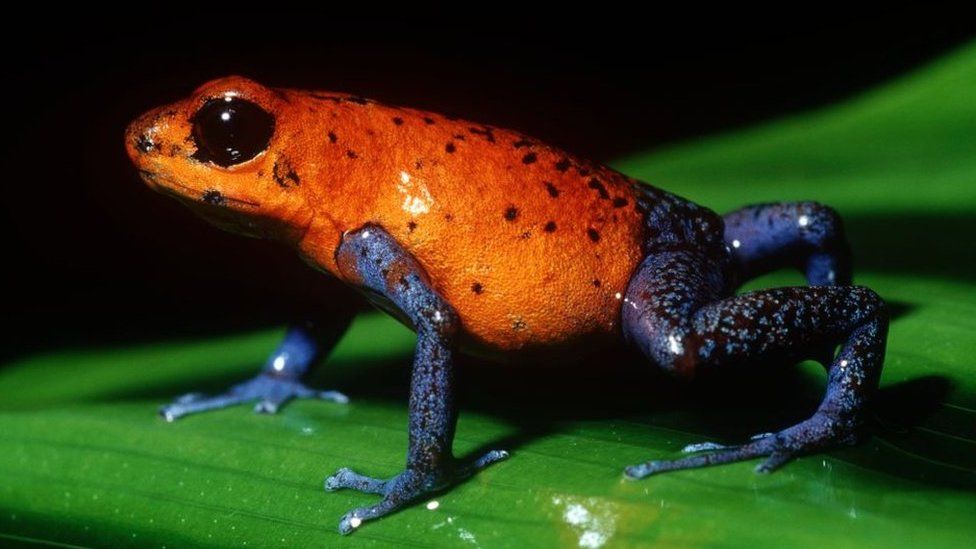Why do poison frogs love to 'tap dance'?
- Published
- comments

This is a strawberry poison dart frog - it might sound tasty, but its skin is highly poisonous
Poison dart frogs can be easily identified by their brightly coloured skin warning potential predators to stay away.
Diminutive in size, they typically measure between 0.75 and 1.5 inches or about 2-4cms - that's roughly the same as the length of a safety pin or an adult bee.
They can be found in the tropical rainforests of South America and for a while now scientists have been puzzled by the frogs displaying some rather curious behaviour.
They appear to make a dancing movement with their back toes, not unlike tap dancing.
The frogs can reach speeds of up to 500 taps per minute - that's around 8 taps a second.
Researchers in the US from the University of Illinois Urbana-Champaign think they might now have an explanation for why this happens.
This is a Dyeing poison dart frog, much like the ones the researchers studied
Biologists Eva Fischer and Thomas Parrish studied a particular species called Dyeing poison dart frogs.
They filmed 22 of these frogs as they were fed live fruit flies - one of their favourite things to eat.
As scientists watched the footage of the frogs receiving their food, they found the frogs tapped far more when food was present - around 389 times a minute.
But, when no food was present, they averaged around 50 taps a minute.
Poison Dart Frog: The facts
While they might look pretty, this frog's colourful skin tells potential predators to stay far away. This frog oozes poison through its skin.
There is evidence of aboriginal South Americans using the poison from some species to coat darts shot from blowguns to make them more deadly, and this is how the poison dart frog got its name.
A large poison dart frog measures only 1.5 inches (nearly 4 cm) in length, but many species are much smaller.
A group of poison dart frogs is known as an army.
The scientists also found the number of taps depended on what type of surface the frog was sitting on.
If the frog was on glass or soil, it tapped far less than it would on leaves.
Scientists now believe this is because a surface like leaves carries vibrations much better.
"Frogs can only really forage when prey is alive and moving," Eva Fischer said.
"So maybe this tapping could be vibrationally startling the flies and making them move?"
The frogs tapped more frequently on leaves than on a harder surface like glass
More research is needed to work out whether the tapping is the frogs deliberately trying to make their prey move, or if perhaps the frogs are simply very excited by the thought of eating.
The study still has to be peer-reviewed, meaning other scientists need to look at it for any errors, but another study published in November 2023 had similar findings.
Scientists from the University of Magdalena in Colombia discovered that some frogs accelerated their toe-tapping before attacking their prey.
"It's a potentially really interesting example of a predator using sensory cues to manipulate prey behaviour — at least there's that possibility," said Reginald Cocroft one of the study's authors from the University of Missouri.
- Published29 February
- Published2 March
- Published3 February 2023
